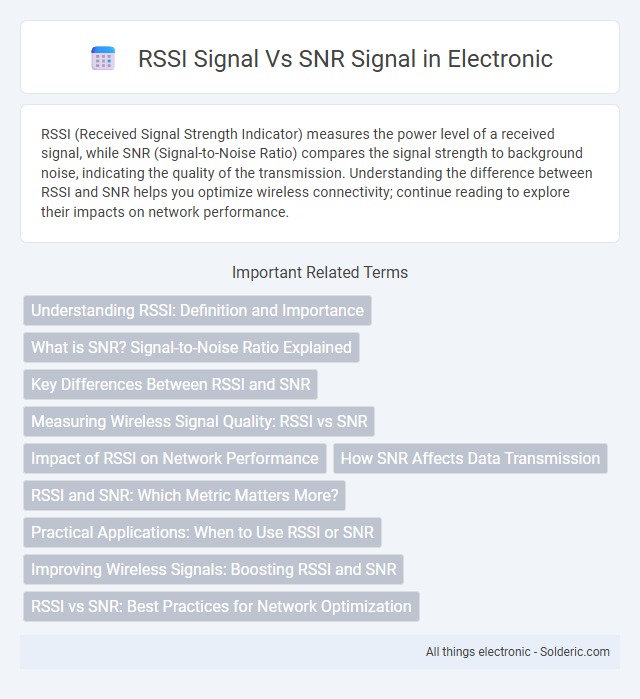RSSI (Received Signal Strength Indicator) measures the power level of a received signal, while SNR (Signal-to-Noise Ratio) compares the signal strength to background noise, indicating the quality of the transmission. Understanding the difference between RSSI and SNR helps you optimize wireless connectivity; continue reading to explore their impacts on network performance.
Comparison Table
| Parameter | RSSI (Received Signal Strength Indicator) | SNR (Signal-to-Noise Ratio) |
|---|---|---|
| Definition | Measures the power level of the received signal. | Measures the ratio of signal power to noise power. |
| Unit | Decibels (dBm) | Decibels (dB) |
| Purpose | Indicates signal strength regardless of noise. | Indicates signal quality relative to noise. |
| Measurement Focus | Absolute received signal power. | Signal clarity by comparing signal vs noise level. |
| Usage | Used for detecting presence and strength of signal. | Used for evaluating communication quality and reliability. |
| Typical Range | -100 dBm (weak) to -30 dBm (strong) | Usually 0 dB (poor) to 40+ dB (excellent) |
| Impact on Connectivity | Strong RSSI does not ensure good connection if noise is high. | High SNR correlates strongly with stable, clear signal. |
Understanding RSSI: Definition and Importance
RSSI (Received Signal Strength Indicator) measures the power level of a received radio signal, indicating the strength of your wireless connection. Unlike SNR (Signal-to-Noise Ratio), which compares signal strength to background noise, RSSI solely reflects signal intensity without noise context. Understanding RSSI is crucial for optimizing network performance, as a higher RSSI value typically correlates with better connectivity and fewer signal drops.
What is SNR? Signal-to-Noise Ratio Explained
Signal-to-Noise Ratio (SNR) measures the level of a desired signal relative to the background noise, expressed in decibels (dB). A higher SNR indicates a cleaner and more reliable signal, essential for wireless communication quality. Unlike RSSI, which quantifies signal strength, SNR provides insight into signal clarity by comparing the power of the signal to the power of noise interference.
Key Differences Between RSSI and SNR
RSSI measures the power level of a received radio signal and indicates signal strength, whereas SNR quantifies the ratio between the desired signal and background noise, reflecting signal quality. Higher RSSI values do not always guarantee better communication, as a high RSSI with low SNR can still result in poor performance due to interference. Understanding these differences helps you optimize wireless network configurations for improved connectivity and reliability.
Measuring Wireless Signal Quality: RSSI vs SNR
RSSI (Received Signal Strength Indicator) measures the power level of a wireless signal, providing insight into signal strength but not directly indicating quality. SNR (Signal-to-Noise Ratio) quantifies the ratio between the desired signal and background noise, offering a more accurate assessment of link quality and potential data transmission performance. High RSSI values combined with high SNR values indicate strong and clear wireless connectivity, critical for optimizing network reliability and throughput.
Impact of RSSI on Network Performance
RSSI (Received Signal Strength Indicator) directly measures the power level of a wireless signal, impacting your network's connection stability and coverage area. A high RSSI value typically enhances data transmission rates and reduces packet loss, leading to smoother performance. However, RSSI alone does not account for signal interference or noise, which can only be assessed by SNR (Signal-to-Noise Ratio) for a complete understanding of network quality.
How SNR Affects Data Transmission
SNR (Signal-to-Noise Ratio) directly impacts data transmission quality by measuring the proportion of meaningful signal to background noise, with higher SNR values indicating clearer communication channels and fewer errors. While RSSI (Received Signal Strength Indicator) measures the power level of the received signal, it does not account for noise, making SNR a more reliable metric for evaluating transmission performance. Your data integrity and speed improve significantly when maintaining a high SNR, ensuring efficient and stable wireless connections.
RSSI and SNR: Which Metric Matters More?
RSSI measures the total power level received by a wireless device, indicating signal strength but not quality, while SNR represents the ratio of signal power to background noise, directly reflecting signal clarity and reliability. In wireless communication, SNR is generally more critical for assessing performance since higher SNR values correspond to better data transmission and reduced error rates. Evaluating both RSSI and SNR together provides a comprehensive understanding of wireless link quality, but SNR remains the more decisive metric for signal integrity.
Practical Applications: When to Use RSSI or SNR
RSSI (Received Signal Strength Indicator) is useful for estimating the power level of a wireless signal, making it ideal for applications like network troubleshooting and device proximity detection. SNR (Signal-to-Noise Ratio) provides a measure of signal quality by comparing signal strength to background noise, which is crucial for optimizing data transmission and improving communication reliability. You should rely on RSSI when checking signal availability and use SNR to assess connection stability and performance in noisy environments.
Improving Wireless Signals: Boosting RSSI and SNR
Improving wireless signals involves enhancing both RSSI (Received Signal Strength Indicator) and SNR (Signal-to-Noise Ratio) to ensure robust connectivity and data transmission quality. Boosting RSSI increases the power level of the received signal, which can be achieved through optimized antenna placement and reducing physical obstructions. Enhancing SNR focuses on minimizing background noise and interference, utilizing noise-canceling technologies and advanced modulation techniques for clearer and more reliable wireless communication.
RSSI vs SNR: Best Practices for Network Optimization
RSSI measures the total received signal strength, while SNR indicates the quality of the signal by comparing it to background noise, making SNR a more reliable metric for network optimization. Your network's speed and stability improve significantly when you prioritize environments with high SNR, as it directly impacts error rates and data throughput. To maximize performance, use RSSI for initial signal existence checks and rely on SNR for fine-tuning and optimizing your wireless network configuration.
RSSI signal vs SNR signal Infographic

 solderic.com
solderic.com